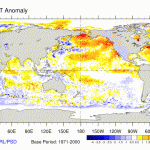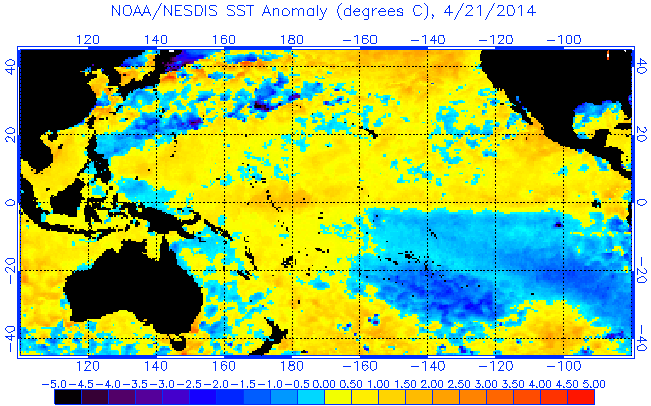An animation of how sea surface temperatures have departed from the long-term average over the past six months. (Source: NOAA) The U.S. Climate Prediction Center has just come out with it's monthly update on the evolution of a long-anticipated El Niño in the Pacific Ocean. And the envelope please: Keep waiting... From the CPC Diagnostic Discussion report issued this morning:
The consensus of forecasters indicates a 2-in-3 chance of El Niño during the November 2014 - January 2015 season. This El Niño will likely remain weak . . . throughout its duration.
Those odds are essentially unchanged from last month. You can sort of see El Niño trying to be born in the animation above. It shows how sea surface temperatures have departed from the long-term average over the past six months.

SST anomalies on Oct. 7. normal. (Source: NOAA) When the animation starts in late April, sea surface temperatures along the equator (0 degrees) in the central and eastern Pacific are close to normal or perhaps a bit warm. Starting in May and into June and July, those waters warm — which is what you'd expect as conditions slide toward an El Niño. By October, above-average sea surface temperatures continue across much of the equatorial Pacific. But as of yet, no cigar. Why should you care about El Niño? It can have wide-ranging impacts on the weather, including in the United States. Here's a summary of what El Niño typically brings, from NOAA:
The impacts of El Niño upon climate in temperate latitudes show up most clearly during wintertime. For example, most El Niño winters are mild over western Canada and parts of the northern United States, and wet over the southern United States from Texas to Florida. El Niño affects temperate climates in other seasons as well. But even during wintertime, El Niño is only one of a number of factors that influence temperate climates. El Niño years, therefore, are not always marked by "typical" El Niño conditions the way they are in parts of the tropics. See List of impacts on the U.S.and List of impacts onother countries.














